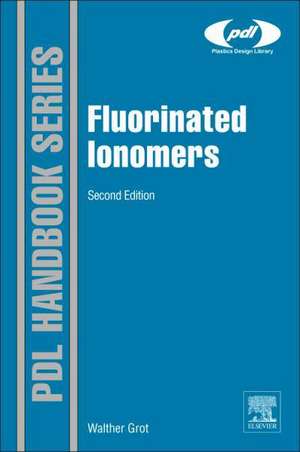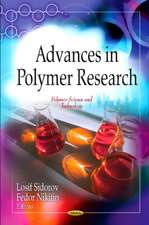Fluorinated Ionomers: Plastics Design Library
Autor Walther Groten Limba Engleză Hardback – 28 iul 2011
- An essential reference for scientists working with electrolysis and electrochemical processes (the use of this polymer group in industrial chemistry processes is credited with a 1% reduction in global electricity usage)
- Covers the techniques involved in the growing range of applications for fluorinated ionomers, including fuel cells, batteries and drug delivery The only book on this important polymer group, written by Walther Grot, the inventor of the leading fluorinated ionomer, Nafion® from DuPont
Din seria Plastics Design Library
-
 Preț: 765.15 lei
Preț: 765.15 lei - 20%
 Preț: 843.44 lei
Preț: 843.44 lei - 23%
 Preț: 1297.01 lei
Preț: 1297.01 lei - 24%
 Preț: 1051.90 lei
Preț: 1051.90 lei - 9%
 Preț: 1010.64 lei
Preț: 1010.64 lei - 9%
 Preț: 1284.33 lei
Preț: 1284.33 lei - 28%
 Preț: 742.62 lei
Preț: 742.62 lei - 25%
 Preț: 924.71 lei
Preț: 924.71 lei - 24%
 Preț: 639.28 lei
Preț: 639.28 lei - 24%
 Preț: 927.35 lei
Preț: 927.35 lei - 23%
 Preț: 808.47 lei
Preț: 808.47 lei - 5%
 Preț: 638.39 lei
Preț: 638.39 lei - 23%
 Preț: 604.24 lei
Preț: 604.24 lei - 9%
 Preț: 1425.34 lei
Preț: 1425.34 lei - 23%
 Preț: 685.29 lei
Preț: 685.29 lei - 13%
 Preț: 1231.87 lei
Preț: 1231.87 lei - 23%
 Preț: 1520.22 lei
Preț: 1520.22 lei - 9%
 Preț: 1242.23 lei
Preț: 1242.23 lei - 23%
 Preț: 939.42 lei
Preț: 939.42 lei - 23%
 Preț: 938.47 lei
Preț: 938.47 lei - 23%
 Preț: 1015.82 lei
Preț: 1015.82 lei - 9%
 Preț: 1524.00 lei
Preț: 1524.00 lei - 29%
 Preț: 1210.89 lei
Preț: 1210.89 lei - 18%
 Preț: 880.13 lei
Preț: 880.13 lei - 19%
 Preț: 1522.28 lei
Preț: 1522.28 lei - 24%
 Preț: 727.69 lei
Preț: 727.69 lei - 16%
 Preț: 759.03 lei
Preț: 759.03 lei - 9%
 Preț: 843.44 lei
Preț: 843.44 lei - 23%
 Preț: 695.34 lei
Preț: 695.34 lei - 9%
 Preț: 804.32 lei
Preț: 804.32 lei - 17%
 Preț: 1089.51 lei
Preț: 1089.51 lei - 23%
 Preț: 1144.96 lei
Preț: 1144.96 lei - 23%
 Preț: 1259.53 lei
Preț: 1259.53 lei - 9%
 Preț: 645.57 lei
Preț: 645.57 lei - 28%
 Preț: 1318.75 lei
Preț: 1318.75 lei - 9%
 Preț: 1249.48 lei
Preț: 1249.48 lei - 24%
 Preț: 933.91 lei
Preț: 933.91 lei - 9%
 Preț: 803.90 lei
Preț: 803.90 lei - 9%
 Preț: 927.17 lei
Preț: 927.17 lei - 24%
 Preț: 919.72 lei
Preț: 919.72 lei - 18%
 Preț: 1499.61 lei
Preț: 1499.61 lei - 9%
 Preț: 1511.15 lei
Preț: 1511.15 lei - 24%
 Preț: 729.68 lei
Preț: 729.68 lei - 28%
 Preț: 852.41 lei
Preț: 852.41 lei - 18%
 Preț: 1086.04 lei
Preț: 1086.04 lei
Preț: 849.90 lei
Preț vechi: 1108.93 lei
-23% Nou
Puncte Express: 1275
Preț estimativ în valută:
162.62€ • 169.79$ • 134.60£
162.62€ • 169.79$ • 134.60£
Carte tipărită la comandă
Livrare economică 28 martie-11 aprilie
Preluare comenzi: 021 569.72.76
Specificații
ISBN-13: 9781437744576
ISBN-10: 1437744575
Pagini: 312
Ilustrații: Illustrated
Dimensiuni: 152 x 229 x 28 mm
Greutate: 0.91 kg
Ediția:2
Editura: ELSEVIER SCIENCE
Seria Plastics Design Library
ISBN-10: 1437744575
Pagini: 312
Ilustrații: Illustrated
Dimensiuni: 152 x 229 x 28 mm
Greutate: 0.91 kg
Ediția:2
Editura: ELSEVIER SCIENCE
Seria Plastics Design Library
Public țintă
Cluster E-brochure, trade shows and conferences, online display ads, 2x-Email blast to in-house subsCuprins
1 Introduction1.1 Polymers1.2 Physical Shapes1.3 References2 History2.1 References3 Manufacture3.1 Introduction3.2 Perfluorinated Ionomers3.3 Polymerization3.4 Fabrication3.5 Hydrolysis and Acid Exchange3.6 Finishing and Testing3.7 Liquid Compositions3.8 Fluorinated Ionomers with Phosphonic or Sulfonyl Imide Functional Groups3.9 Partially Fluorinated Ionomers3.10 Composite Materials of Ionomers and Inorganic Oxides3.11 Composite Materials of Ionomers and a Porous Matrix3.12 Remanufactured Membranes3.13 References4 Properties4.1 Properties of the Precursor Polymers4.2 Properties of the Ionic Forms4.3 Morphology4.4 Transport Properties4.5 Optical Properties4.6 Thermal Properties4.7 Stability4.8 References5 Applications5.1 Electrolysis5.2 Sensors and Actuators5.3 Dialysis5.4 Gas and Vapor Diffusion5.5 Protective Clothing5.6 Catalysis5.7 References6 Fuel Cells and Batteries6.1 Introduction6.2 Operating Parameters6.3 Ionomer Stability6.4 Direct Methanol Fuel Cells (DMFCs)6.5 Manufacture of MEAs6.6 Rechargeable Flow Through Batteries6.7 References6.8 Further Reading7 Commercial Membrane Types7.1 Unreinforced Perfluorinated Sulfonic Acid Films7.2 Reinforced Perfluorinated Membranes8 Economic Aspects8.1 Chlor-Alkali Cells8.2 Fuel Cells8.3 References9 Experimental Methods9.1 Infrared Spectra9.2 Hydrolysis, Surface Hydrolysis and Staining9.3 Other Reactions of the Precursor Polymer9.4 Ion Exchange Equilibrium9.5 Determination of EW by Titration or Infrared Analysis9.6 Determining Melt Flow9.7 Distinguishing the Precursor Polymer from Various Ionic Forms9.8 Fenton’s Test for Oxidative Stability9.9 Examination of a Membrane9.10 Determining the Permselectivity9.11 Measuring Pervaporation Rates9.12 Simple Electrolytic Cells9.13 References10 Heat Sealing and Repair10.1 Reference11 Handling and Storage11.1 Handling the Film11.2 Pretreatment11.3 Installation11.4 Sealing and Gasketing12 Toxicology, Safety and Disposal12.1 Toxicology12.2 Safety12.3 Disposal12.4 ReferencesAppendix A A Chromic Acid Regeneration SystemAppendix B Laboratory Chlor-alkali CellAppendix C Solution Cast Nafion FilmAppendix D Plastic-Based Bipolar PlatesSuppliers and ResourcesGlossary and Web SitesIndex





